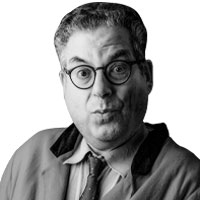
“Cool” is one of those words that is completely meaningless because the second you apply them to someone, they totally evaporate. Being truly cool means never having to say you are, and certainly never having to get anyone else to say it either. But I’d make an exception for Lou Reed. Dripping with NYC attitude and angst, Lou was the epitome of cool from day one, when his impenetrable shades, leather jacket, and droning voice made him the modern day answer to the tough, bisexual antiheroes of 1950s cinema. The man was cool personified, and his passing due to his liver-related ailment today at age 71 sounds the death knell for irony-laden rock chic.
Brando and Dean by way of Cale and Bowie, Lou had an acid-drenched view of the world’s horrors, but he infused it with wry wit and sweet sentiment that made his world a haunting place of dark romance and transcendence-seeking. He’ll always have a place in the history books for having gotten a chart hit out of transvestism, drugs, and prostitution by way of “Walk on the Wild Side,” his 1972 song that detailed the Warhol superstars’ original treks to New York, which they brought to its knees (while they were on their knees). The song became my guidebook to the freaks and fabbies I’d missed out on because I was still in school at that time and actually doing my homework. It was my invaluable introduction to the wonderfully racy glamour of the nightlife underworld, and with the record’s deadpan vocals and woozy guitar riffs, backed by “colored girls” do-wopping, it made me a believer—in transvestism, prostitution, and Lou Reed.
Those themes remained Reed favorites with his ’73 album Berlin, which I picked up in a one-dollar bargain bin in L.A. three years later, and which changed my life all over again. I was mad for the junkies-in-love theme and loved the decadent use of Berlin as a bleak and hazy backdrop for a zoned-out rock opera of a concept album. This one made the Who’s Tommy look like Mary Poppins by comparison. The despairing songs could never be chart hits, but that made them all the more delicious, with certain phrases searing into my impressionable young mind forever. (One example: “After the applause had died down…,” with Lou perversely leaning on the “the”.)
By the late ‘70s, I was running around rock clubs in my own leather jackets, and the occasional sighting of Lou was absolutely golden. Spotting the Velvet Underground legend at the wildly popular Tribeca dive the Mudd Club, I just stood there, transfixed, making as much of a fool of myself as if I’d bowed and scraped and held out a head shot to autograph.
This was way before the Internet and lots of cable channels sucked up the underground and spit it out into the mainstream so you didn’t have to leave the house anymore to walk on the wild side. This was before massive gentrification and rising community board tyranny, when New York City was still full of offbeat discoveries known only to the insiders, where eccentricity and individualism were rewarded, and if you could turn your righteous anger into some form of heady cultural expression, you were a star after midnight. Lou was a walking beacon for all that—a petite, gauntly handsome champion of the oppressed and the poetically afflicted, a man whose work keeps growing in stature as critics take a step back and realize what an uncompromising treasure trove he left behind. The godfather of punk, with a heavy dose of glam, Lou collaborated with all the right people, and always seemed to eventually make up with them in time to collaborate with them some more. A NYC original, he influenced so many musicians that even Miley Cyrus sent out a tweet mourning his loss yesterday!
Some of the horrors he lived through imbued his work with a radiantly pained wisdom. Brooklyn-born Lou grew up with bisexual feelings, but when he was a teen, his parents forced him to undergo electroconvulsive therapy, which was damaging and horrific, but at least led to one of his great songs, “Kill Your Sons” from 1974’s Sally Can’t Dance album. In the song, Lou carries on about how the therapy led to memory burnout, but I doubt it made him forget to love men for the rest of his life.
It was with wife Laurie Anderson, though, that he seemed to find a perfect partner, and I enjoyed the fact that image-wise, they threatened to scale new heights of fascinating pretension. They were certainly higher reaching, attitude-wise, than the crass attention-seeking couples you generally read about. And even if Lou was far from the warmest public figure out there—in fact, a lot of press people were terrified of him—the vibe totally worked. You didn’t want Lou Reed to be a press-hungry red carpet celebrity doling out happy sound bites like everyone else. We needed him to be wary, absorbed, and a little bit gruff, and he gamely complied, thereby furthering his own self-made legend.
I thought Lou would be around forever—not only to keep creating, but as a walking reminder of New York’s days of skinny ties and colorful nihilism. He was rock and roll royalty, as photographer/director Timothy Greenfield-Sanders, a longtime friend of Lou’s, just noted to me. Said Greenfield-Sanders:
“I remember standing onstage at Madison Square Garden for David Bowie’s 50th birthday in 1997, getting ready to photograph Lou, who was about to play with his old friend from the Transformer days. Bowie announced the upcoming performance by saying, ‘And now, the king of New York, Lou Reed.’ Lou was the king of New York. Lou represented what we all loved about New York, what was cool, edgy, transgressive. Lou was why we came to New York.”
Cool.






